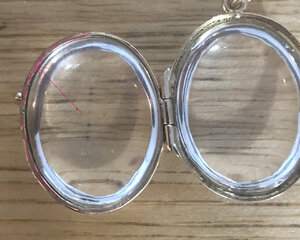Not sure where to post this it's a follow up from a thread I had about the quartz being a tad loose and I wanted to start a new thread on the gold.
This was sold as 9c, untested. Seller looked through a Loupe to see if there were chips or wear to the gold plating, no.
I've tested it extensively and had a 3rd party jeweler test it.
It's def 14 k
Everything tests positive down to the hinge, except th e inner parts of the front opening.
The outer opening is thin, but the edge of the inner opening, you can see, has a flat area where it meets the inside of the outer piece.
This tests as something not gold.
I've scratched the same areas on the outer bezel prob up to 10x hard on the test stone and they still test as 14 k along with testing as 14 k on 2 different KEe testers.
So...
Is it plated
or
Is the inside lip made of something else?
It seems like, if you look at the right side being as thin as it is that with me scratching the same area 10x I'd have worn it down. I also filed it with a stainless steel file. Same result 14k.
Does anyone have enough knowledge of lockets that would they have used a different material on the inside lip?
I know with my victorian lockets (silver) they have an inner frame that's often not silver and placed around the inside lip for strength. It never tests as silver.
Do they do this with gold also... or would you assume this is plated?
I need to get bak wit the seller. I would like to keep this but not sure on the price I paid if it's plated.The red line area is what is not testing as gold.
This area on the other side, tests as gold.

This was sold as 9c, untested. Seller looked through a Loupe to see if there were chips or wear to the gold plating, no.
I've tested it extensively and had a 3rd party jeweler test it.
It's def 14 k
Everything tests positive down to the hinge, except th e inner parts of the front opening.
The outer opening is thin, but the edge of the inner opening, you can see, has a flat area where it meets the inside of the outer piece.
This tests as something not gold.
I've scratched the same areas on the outer bezel prob up to 10x hard on the test stone and they still test as 14 k along with testing as 14 k on 2 different KEe testers.
So...
Is it plated
or
Is the inside lip made of something else?
It seems like, if you look at the right side being as thin as it is that with me scratching the same area 10x I'd have worn it down. I also filed it with a stainless steel file. Same result 14k.
Does anyone have enough knowledge of lockets that would they have used a different material on the inside lip?
I know with my victorian lockets (silver) they have an inner frame that's often not silver and placed around the inside lip for strength. It never tests as silver.
Do they do this with gold also... or would you assume this is plated?
I need to get bak wit the seller. I would like to keep this but not sure on the price I paid if it's plated.The red line area is what is not testing as gold.
This area on the other side, tests as gold.





300x240.png)